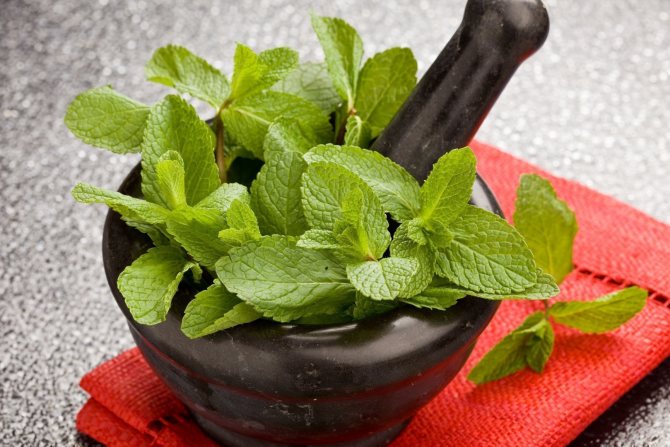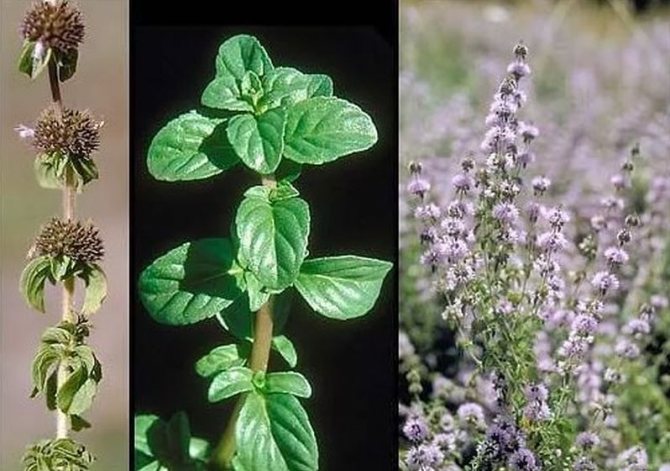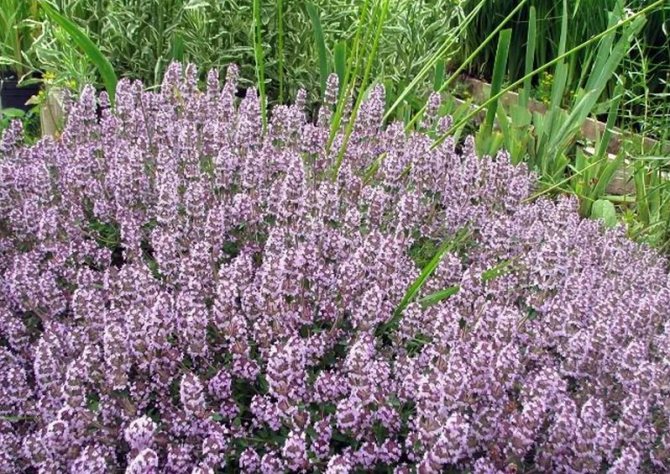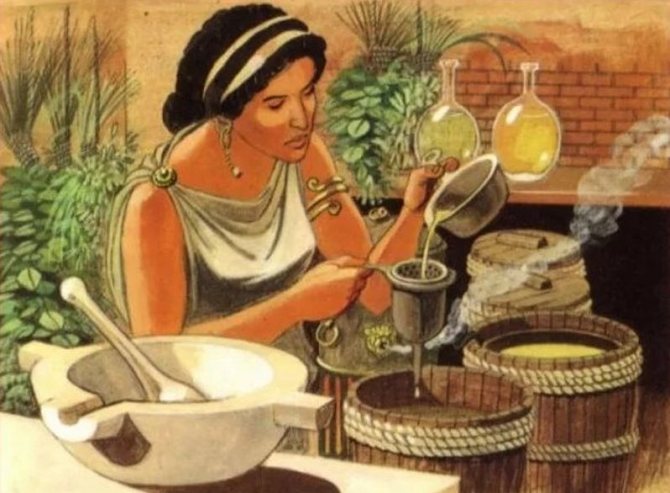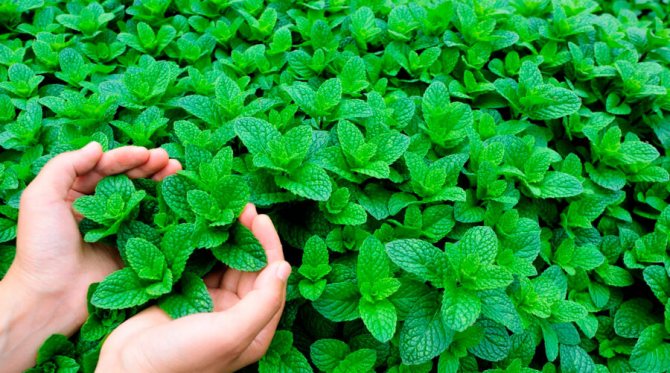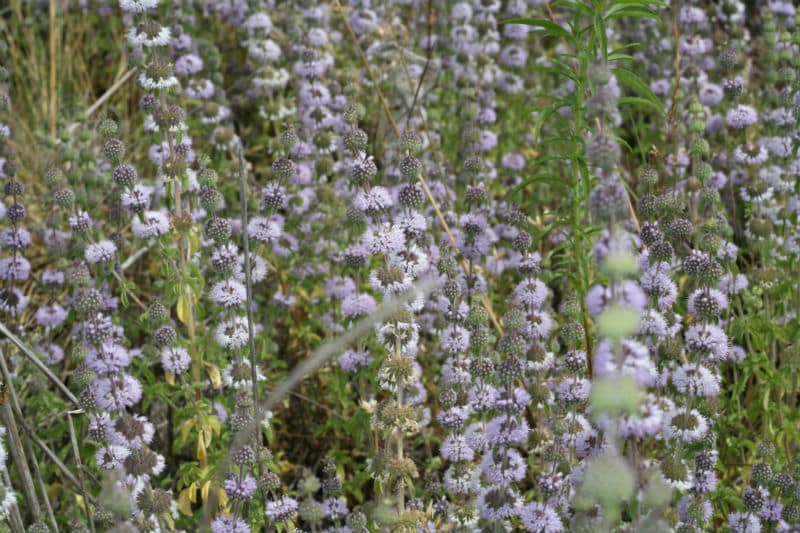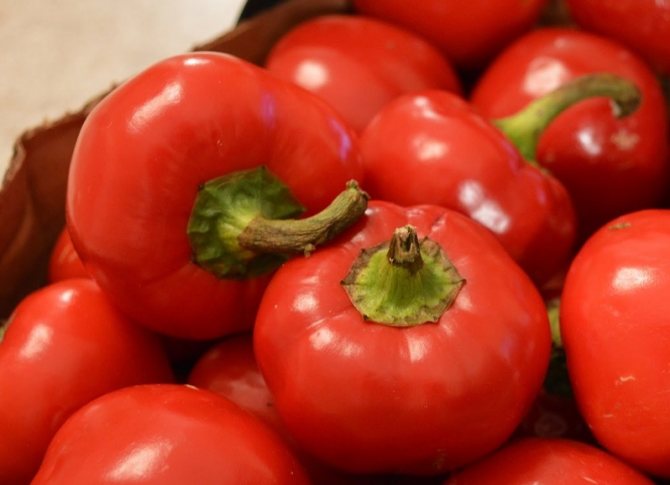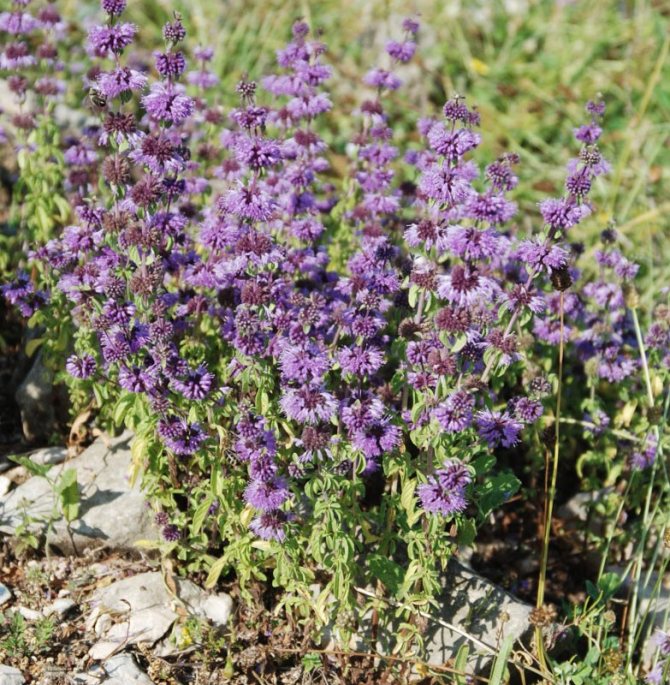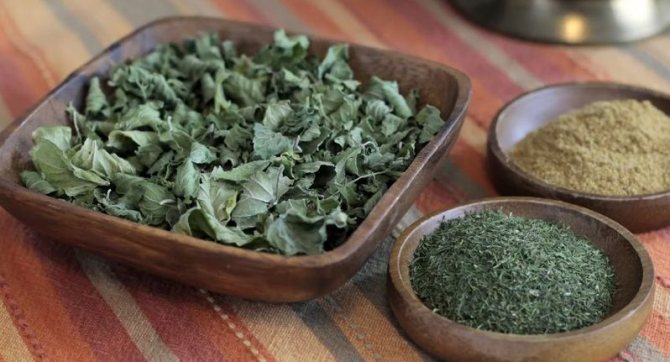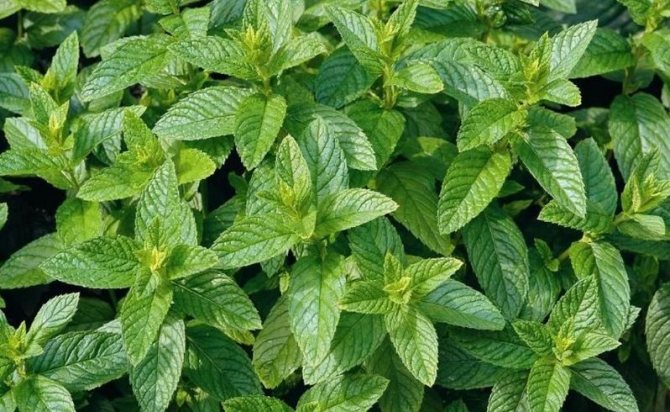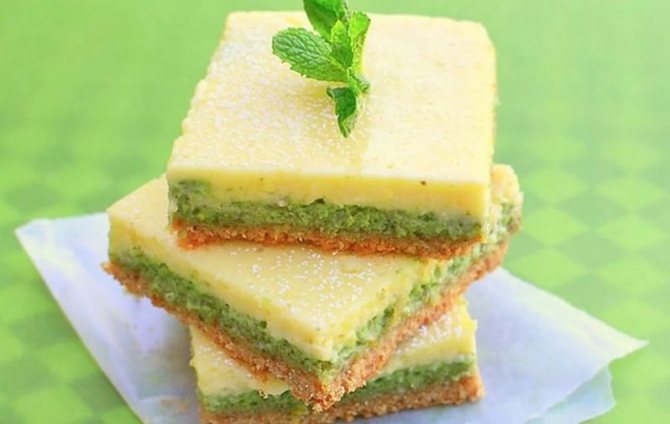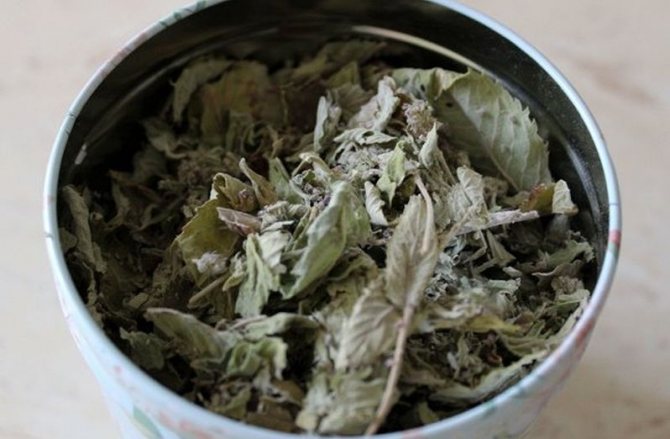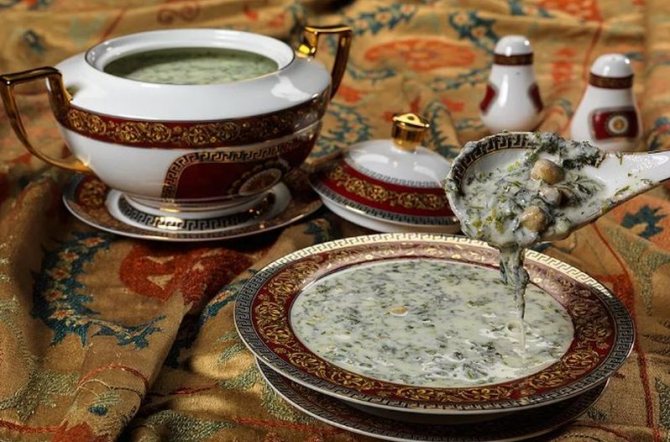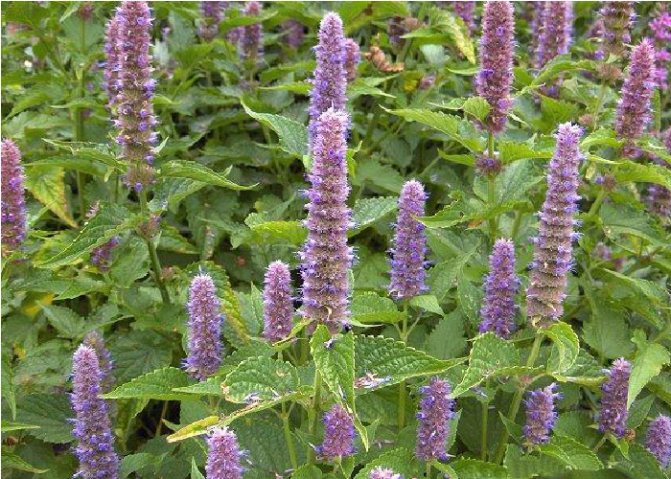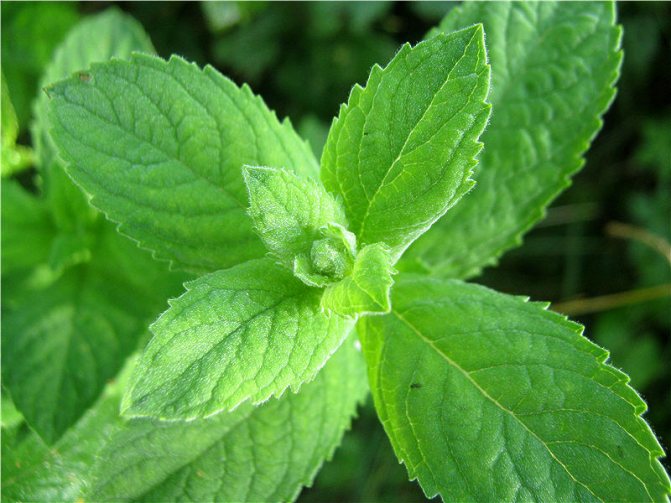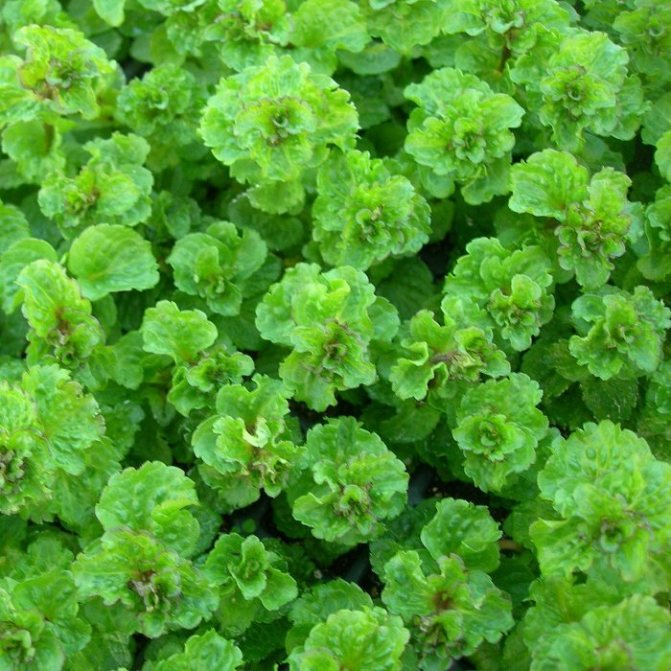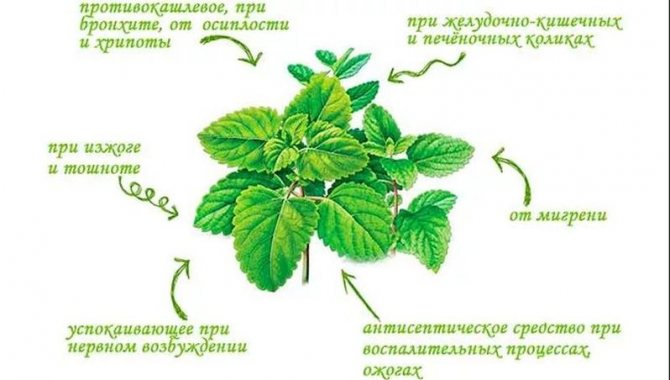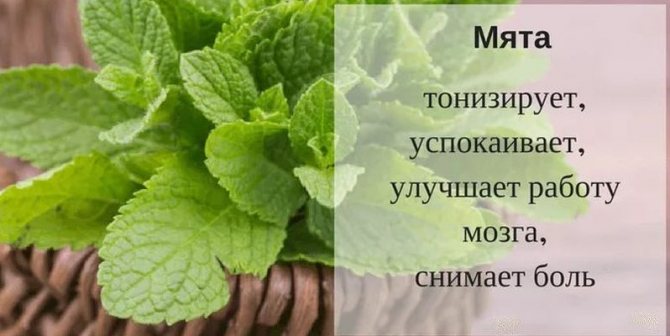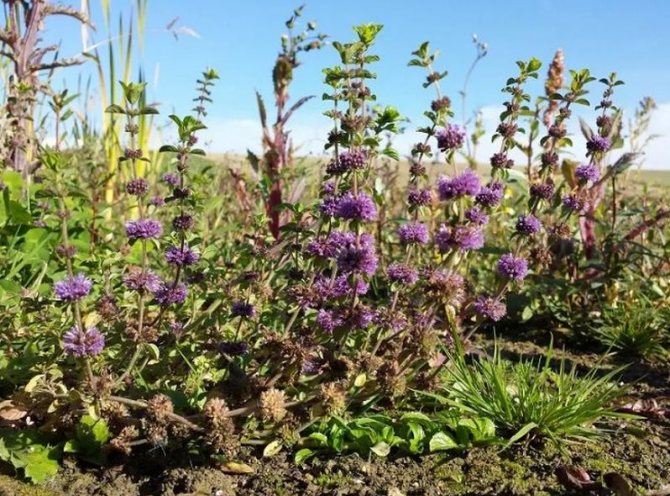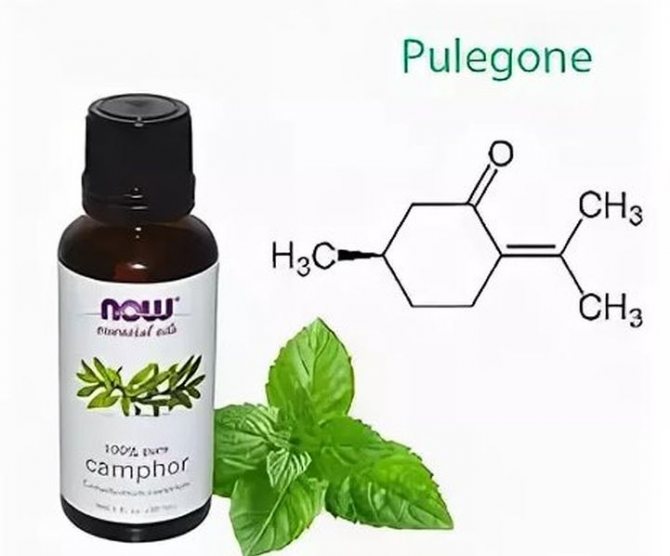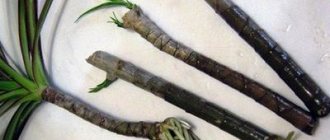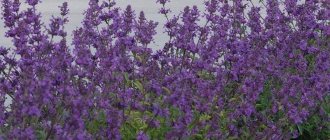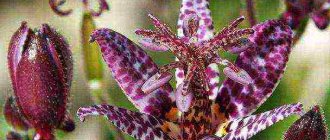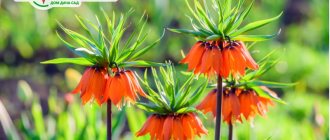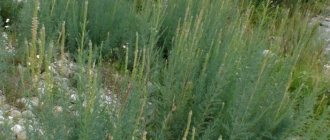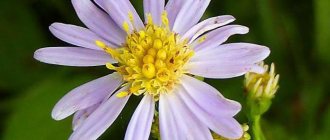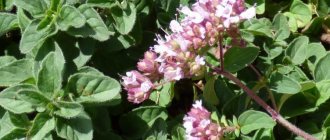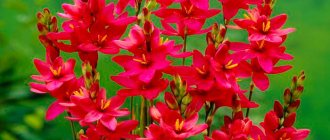- Features of the view
- Landing rules
- Care
- Reproduction methods
- Rhizome
- Cuttings
- Pests
- Diseases
- Prophylaxis
- Application
Decorative, useful and unpretentious in care Curly mint has become a favorite of many gardeners. This unique plant is not demanding on the soil. Its succulent leaves are rich in nutrients and are widely used in modern medicine and cooking.
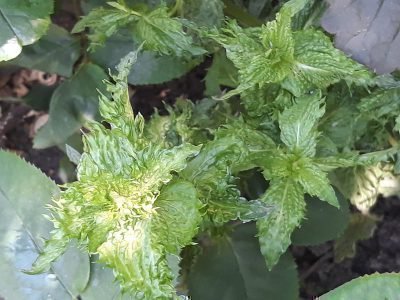
The curly variety got its name due to its characteristic leaves.
Pepper
The most famous and widespread variety. It got its name from the strong pungency of the taste of the leaves.
Refers to a perennial ornamental variety. Does not grow in the wild. It is a good honey plant. The stem height reaches up to 1 meter. Leaves are ovoid.
In garden plots, it is grown as a gardener. In industrial sectors, it is used in medicine and perfumery. It is added as a food additive in the preparation of many dishes and desserts.
It has a great healing effect on the human body. Improves digestion, helps in the fight against liver and gallbladder diseases.
Has a beneficial effect on the central nervous system. It is useful for inflammation of the female genital organs. Increases the tone of skin cells, eliminate the focus of skin inflammation.
Diseases
Rust infestation will be indicated by red spots on the surface of the foliage. If the leaves are covered with a white powdery coating, the plant is sick with powdery mildew. The causative agent of these diseases is a fungus. Diseases spread quickly, therefore, if they are detected, it is necessary to immediately treat them, otherwise you risk losing all landings. Fungicide treatment is carried out one month before the planned harvest. If the infection occurred on the eve of harvesting the leaves, curly mint should be disposed of - removed from the site and burned.
Often affected by anthracnose and leaf spot. In this case, the plants are sprayed with Bordeaux mixture.
Menthol
Refers to the varieties of pepper. It got its name from the high menthol content.
Perennial species. Cultivated in home plots. In the wild, it occurs in forest edges and along the shores of water bodies.
The erect stem reaches up to 100 cm. This variety has pointed leaves, have an oblong-ovoid shape (see the photo). At home, it is grown for landscaping the territory and harvesting fees.
In the Voronezh Oblast and Krasnodar Krai, large fields of menthol mint are grown for use in the medical, cosmetic and culinary industries.
It is used in the manufacture of personal hygiene products: toothpastes, shampoos, aftershave balms, shower gels.
It is added as an additional component in the preparation of hot dishes, desserts and drinks. It is part of many medicines.
Menthol mint is used in the treatment of neurological diseases. It has a strong sedative effect. Restores the work of the digestive tract.
Bioactive substances have an expectorant and disinfecting effect.
Recommended for inflammation of the respiratory system: nose, bronchi, trachea, lungs.
How to care for a variety
Despite the unpretentiousness of the mint, it still needs some care.
Watering and feeding
Irrigation should be carried out as the top layer of the soil dries up. Watering should be moderate, in dry weather they are done every day. Excessive moisture in the soil is fraught with putrefactive processes on the root system of mint mint.
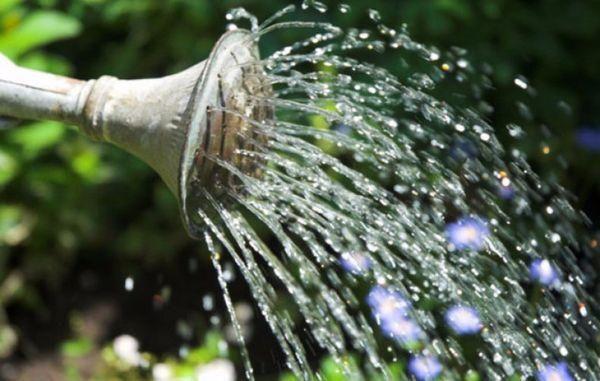

Loosening and removing weeds
To avoid oxygen starvation of the Marshmint roots, it is recommended to loosen the soil after each irrigation. Weed vegetation must be removed regularly, otherwise the soil will quickly deplete.
Prevention and treatment of diseases
Most often, mint mint is infected with fungal diseases. Rust, powdery mildew may appear on the bushes. Such diseases appear as a result of violation of the rules of watering, the introduction of nutrient compositions (excess). Here you will need to transplant to a new place; it is not worth treating with agrochemicals if you plan to further use the leaves of the plant for food.
Insect protection
Parasitic individuals such as leaf beetle, flea, tick, caterpillar, bear can attack mint mint. They eat the green mass of the bush, as well as its underground part. To protect mint mint from pests, it is necessary to spray with a working solution based on celandine (250 grams of raw materials are taken for 8-10 liters).
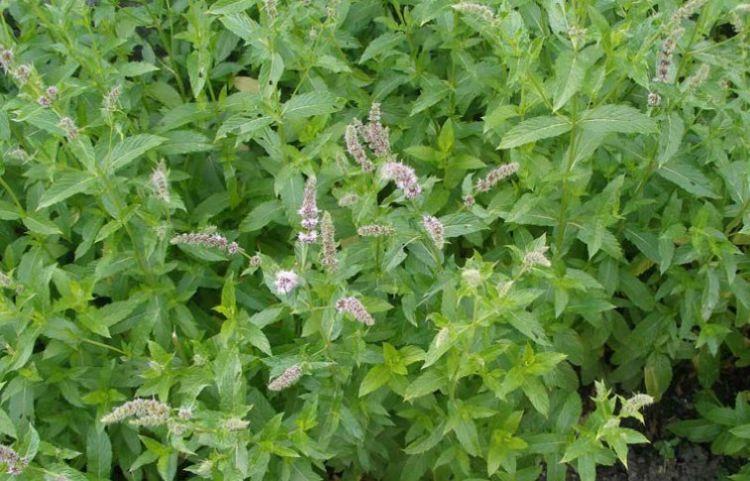

Fragrant
Also known as round-leaved. Has a rich, slightly sweet smell. Thanks to this, it got its name.
Perennial variety. Loves sunny areas with moderate humidity. Widely distributed in the Mediterranean countries and Asia Minor. Stem height about 40 cm.
In rare cases, it reaches up to 1 meter. Leaves are ovoid with soft pubescence and light border.
Due to its attractive appearance, it is grown as an ornamental plant. It is used in cooking, medicine.
Has a calming effect. It is included in most sedatives and fees.
It is prescribed for women during menopause. Mint mouthwash disinfects the oral cavity and reduces gum inflammation.
Normalizes the liver and gallbladder. It dilutes bile, facilitating its stable outflow. Refuses an expanding effect on blood vessels.
Reduces headaches and stabilizes blood pressure. It is recommended to use it for inflammation of the respiratory system during colds.
Care
For intensive growth and development, young seedlings require careful and timely care:
- At first, crops should be watered frequently to prevent drying, yellowing and death of sprouts. Moistening should be moderate and only from a spray bottle so that a crust does not form on the soil surface. It is better to moisturize plants in the evening, when there is no scorching sun.
- A day after each watering, the soil is loosened to increase its aeration (air and moisture permeability). Loosen superficially so as not to damage the young roots.
- Regular fertilization will help plants build strong immunity and quickly build up green mass. Nitrogen and phosphorus preparations are used as food. Top dressing is applied during the growing season. Some gardeners additionally use compost or humus.
- Soil mulching is a prerequisite for care. Mulch is introduced before the onset of cold weather to protect the plantings from freezing. Cover with straw, sawdust or garden soil.
Curly
It has several names: curly, German, spiky. Differs in almost complete absence of menthol.
In the wild, it prevails in the countries of Western Asia and South-Eastern Europe. Perennial species. The stem develops up to 1 meter. The leaves are elongated, with jagged edges, as in the photo.
They are characterized by curly and wrinkled surfaces.Essential oil is widely used in the medical field, soap making and tobacco industry.
It is softer than peppermint. It is used in many medicines for children.
The tincture is useful for difficulty urinating and the treatment of urolithiasis. Normalizes the work of the gastrointestinal tract.
An effective remedy for nausea, vomiting, flatulence and colic. Helps with hemorrhoids. Fights inflammatory diseases: fever, bronchitis.
The warm infusion is suitable for treating skin ulcers. It reduces the infection process and speeds up the wound healing period.
Reproduction methods
In addition to seed cultivation, which is used by many gardeners, Kucheryavaya mint can be propagated by cuttings and rhizomes. So you can get a strong plant while maintaining all the varietal characteristics of the mother bush.
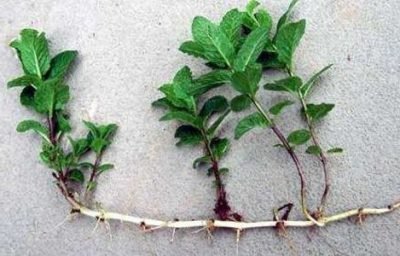

Root shoots of mint
Rhizome
In the spring, when the snow thaws and warm weather sets in, it is necessary to dig out the Curly mint bush. Then divide it with a garden shovel into several parts so that each division has several healthy roots and one green shoot. Places of cuts are powdered with charcoal and dried.
Delenki are planted on a plot with fertile land at a distance of 30-40 cm from each other. After planting, they are watered abundantly - 5 liters of water are consumed per plant.
Further care is the same as for adult specimens.
Cuttings
Cutting of green cuttings is carried out in the summer. Choose strong shoots with multiple buds. The optimum length of shoots is 20 cm. After cutting, the cuttings are immersed in water with a root formation stimulator (Epin, Kornevin or Heteroauxin).
After a few hours of soaking, the cuttings are planted in nutritious and loose soil on the site. Then watered and hilled. You will be able to understand that the shoots have begun by the new leaves.
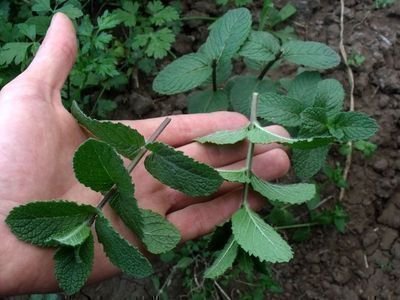

Mint cuttings
Forest
Known as incense. In Europe it is called "oregano".
Widely distributed in the European part. In Russia, it grows everywhere, except for the regions of the Far North.
He chooses meadows and grassy hills as growth. Stems develop up to 90 cm. Leaves are oblong-ovate, grayish-green in color.
Used as a condiment in many dishes. Due to its rich chemical composition, it is widely used in medicine.
Ladanka normalizes the digestive system. Helps in the fight against poisoning and diarrhea. Has a calming effect on the nervous system.
Relieves anxiety, anxiety. It is used as a pain reliever for toothache, joint pain and headache. It has an antibacterial and healing effect. The vitamins that make up the essential oil increase blood clotting.
The metabolism of fats is stabilized, the level of cholesterol is restored. Ascorbic acid helps to increase and strengthen the immune system.
Also helps with inflammation of the urethra and respiratory organs.
Harvesting and harvesting
Marsh mint is harvested in the middle of summer, selecting only healthy specimens. The dried herb is stored in canvas bags or crushed on a coffee grinder, placing them in clean glass containers.
You can also store the mint in plastic bags in the refrigerator, removing excess air from them.
Marsh mint is a medicinal and beautiful herb. It is not difficult to grow it if you know the main points of planting and care. This is a rather unpretentious and healthy culture that should be in every garden.
Field
Herbaceous plant, the second name is meadow mint.
Perennial species. Widespread. Found in Europe and Central Asia. On the territory of Russia, it grows in the European part, Siberia and the Caucasus.
In the wild, it prefers the shores of water bodies and marshlands.Branched stems reach 100 cm. The leaves are serrate-toothed, fluffy during the harvest period.
Differs in a high content of menthol. It is cultivated for use in folk and professional medicine.
Infusions have a calming effect on the central nervous system. Sleep and appetite are normalized, and the frequency of headaches decreases.
It is used for diseases of the digestive tract. Affects the liver and gallbladder. It is useful for cholecystitis, actively dilutes stagnant bile. Fights respiratory diseases.
Eliminates edema, reduces the risk of inflammation. Promotes the expansion of blood vessels in the brain and heart. Stabilizes blood pressure.
Oil solutions with this variety are added to the composition of many medicines: validol, valocordin. Essential oils are used in the production of tooth powders and pastes, mouth rinses.
Pests
Curly mint is often attacked by harmful insects. This happens in the absence of proper care (watering, fertilizing) and regular inspection.
Inveterate pests that eat the aerial part of the plant are mint fleas and aphids. The first type makes holes in the leaf plate, the second folds its tube.
You can get rid of these pests with the help of garlic or onion infusion. Irrigation is carried out 2 times with an interval of 10 days. Spray the crown of the plant and the soil around it.
Moths and mint mites love to feast on curly mint. There is a risk of wireworm damage when planting next to potatoes. Systemic insecticides will help get rid of these parasites.


Aphids damage mint leaves
Doggy
Also called ivy budra. Differs in a pronounced smell.
Perennial, like most varieties. He prefers to live in temperate zones of Eurasia. It grows actively in forests or clearings.
The creeping stem grows up to 50 cm. The leaves are reniform, located on long petioles, this is clearly seen in the photo. It produces honey in the spring and summer.
Refers to the active components of folk healing.
The main area is anti-inflammatory and choleretic agent. Accelerates the removal of sand from the gallbladder. Eliminates inflammatory processes, stabilizes the digestive system.
Used to treat the respiratory system. Thinns phlegm, helps mucus to escape and prevents further development of the disease.
Refers to a powerful diuretic. Helps in the treatment of the urinary system. It has a cooling and wound healing effect.
It disinfects the surface well, reducing the development of infection. You need to be careful when using.
The plant of this variety is considered poisonous.
Prophylaxis
To prevent the appearance of diseases and parasites, follow simple and effective preventive measures:
- regularly remove weeds and plant debris from the site;
- in the fall, carry out a deep digging of the soil to destroy the fungus, larvae that go into the ground for wintering;
- sick plants that can no longer be saved must be immediately removed from the site in order to exclude infection of healthy specimens.
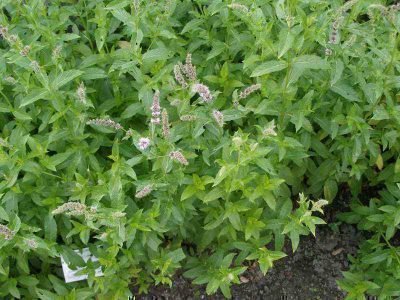

For good growth of mint, the area is cleaned of weeds.
Cat mint
The second name is catnip. It got its name from the thin lemon juice that attracts the active attention of cats.
Perennial herb. In the wild, it grows in wastelands, forest glades.
In the gardening industry it is cultivated as a decorative decoration of the garden. An upright shoot can reach 1 meter, rather fluffy (but not the same as that of the Korean in the next photo). The leaves are triangular-ovoid, sharp.
Used in cooking as a spice. It is used in soap making and perfumery. It is widely used in medicine.
Refers to powerful antiseptic and cooling products.It is prescribed for anemia, replenishes the deficiency of vitamins in the body.
It has a positive effect on the cardiovascular system. Monitors the level of blood pressure. It is used in the treatment of the digestive system.
Stabilizes kidney function. Regulates the work of the nervous system. Reduces feelings of anxiety and anxiety. Recommended for respiratory diseases.
It is a powerful expectorant. Recommended for women in case of problems with the menstrual cycle.
Dates and technology of disembarkation
Growing mint mint is equally effective, both by seed and vegetative methods. The main thing is to know the basic subtleties of each process.
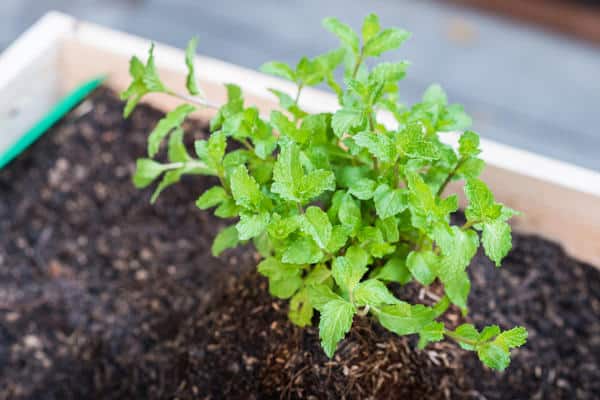

Seeds
The optimal time for sowing is the beginning of April. Marshmint seeds mixed with sand are evenly spread on a pre-moistened soil, lightly sprinkled with sand and moistened with a spray bottle. The distance between seedlings should be 15-20 centimeters, the depth of the groove should be 2-3 centimeters.
If the seedlings of marsh mint were sown in containers, then the plants are planted in a permanent place after 3-4 leaves appear.
Cuttings
Dates of grafting - early spring-early August. To get cuttings, you need to cut 10 centimeters long shoots from the bush and root them in wet sand or water. Planting of mint cuttings in a container with sand is carried out at an angle of 45 degrees, after which they are covered with polyethylene to create a greenhouse effect.
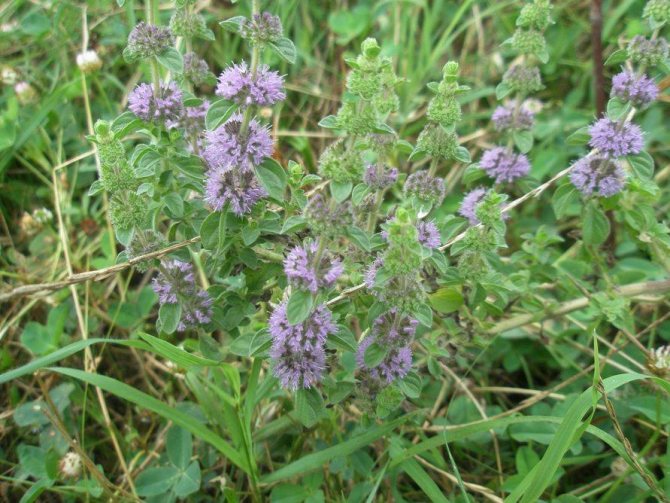

Periodically they are ventilated, moistened, and after 1-2 weeks they are determined to a permanent place. The plants are deepened by no more than 5 centimeters, maintaining a distance between plantings of 15 centimeters.
Korean
Known as the Tibetan lofant. Good honey plant.
Perennial. Wildlife growth has all but disappeared. Loves fertile soil in sunny places. This variety can grow up to 1 meter long.
Differs in tubular purple flowers, collected in spike-shaped inflorescences. Cultivated as an ornamental plant, it is used as part of medicinal preparations.
Widely used in the medical and cosmetic industries, cooking.
Healing tea has a calming effect on the nervous system. Cosmetics containing Korean mint even out skin tone, normalizing its tone and preventing aging processes.
It cleanses the blood well, removes heavy metals from the body. Normalizes blood pressure. Recommended for use in viral and respiratory diseases: asthma, pneumonia, bronchitis, flu.
Has a therapeutic effect on the liver and gallbladder. Used in the treatment of hepatitis C.
Normalizes the work of the gastrointestinal tract, restores metabolism. For the treatment of male health, it is used for prostatitis, actively increases potency.
Landing rules
This plant loves to grow in loose and fertile soil. If planted in acidified soil, you should not expect good growth and dense foliage. Also, a spicy culture grows poorly on waterlogged and knocked down soil. The best place to plant would be a sunny area with a little shade.
Before planting, the site should be cleaned of plant residues and weeds, thoroughly leveled and fertilized with organic matter (for 1 square meter of area 3 kg of compost or rotted manure). Additionally, you can add mineral dressings - phosphorus and potassium, 50 g per 1 sq. m. area.
Seeds are harvested after full ripeness - in mid-October. They can be sown immediately after collection in seedling boxes, or they can be kept in the refrigerator until spring. And with the onset of warm days, sow in open ground.
When planting seeds, not too deep grooves are pulled out - 3-4 cm deep.A distance of 15-20 cm is left between the grooves.For uniform sowing, seeds are mixed with coarse sand in a ratio of 1: 5. After sowing, the seeds are buried with garden soil, slightly compacted and abundantly irrigated with a spray bottle.
Curly mint seeds, like parsley seeds, hatch within two weeks. While they are sprouting, the area should be regularly cleaned of weeds that can interfere with the germination of seedlings.
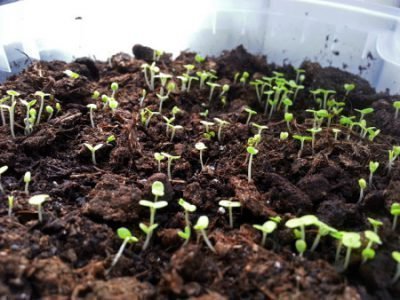

Fertile soil is needed for good seedling growth.
Japanese
Rare view. Endemic to the Japanese islands.
Perennial. It grows on the islands of Honshu and Hokkaido, where the photo was taken. Prefers moist, swampy forests. It is distinguished by a short stem (develops up to 40 cm) and small parts in general.
In Japan, it is grown to decorate garden plots. Wide industrial application. Due to the high content of fragrant essential oils, it is used in cooking as a spice or spice, to decorate ready-made dishes and desserts.
An active ingredient in cosmetic and perfumery products. In Russia, it is sold only in specialized stores.
Step by step instructions: how to use a flea?
In cooking
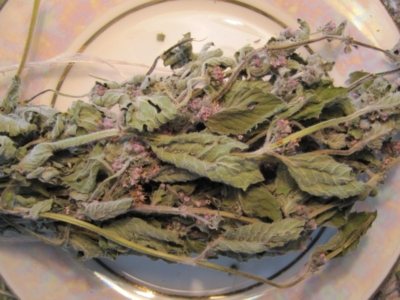

Dried leaves are used:
- In the first and second courses of beef, pork and lamb.
- For the preparation of Georgian seasoning Khmeli-suneli and Tkemali sauce.
- Sauces and pie fillings.
- In Armenia - for flavoring homemade cheeses.
- For the preparation of tea mixtures.
- As a natural flavoring agent in fruit and berry preservation.
Fresh mint leaves are used:
- For decorating cakes, desserts and ice cream.
- For flavoring alcoholic and non-alcoholic beverages, liquor, vinegar, tea.
For medicinal purposes
- Bronchial asthma and bronchitis.
- Cold.
- Gastrointestinal diseases.
- Gout.
- Nervous system disorders, stress and sleep disturbances.
- Delayed menstrual cycle.
- Stimulation of cardiac activity and strengthening of the walls of blood vessels.
- Relief of cramps (relieves headaches, menstrual, stomach aches).
- Cholelithiasis.
- For gum disease and stomatitis.
- To improve bad breath.
- Skin diseases.
Moroccan
A relative of peppermint. The name is associated with the country of origin. Contains a small amount of menthol.
Refers to perennial varieties. Prefers fertile soil. Grows in sunny, moderately moist places. Frost resistant. The stem does not exceed 70 cm, the leaves are dentate. The farm is grown for collection and as a decorative species.
Widely used in the culinary and medical industries. A popular additive in the production of alcoholic beverages and tobacco.
Infusions with the addition of Moroccan mint have a beneficial effect on the nervous system. Essential oils enhance immunity and normalize blood pressure.
Peppermint dilates the blood vessels of the heart and brain, thus increasing blood levels and reducing headaches.
It is used for inflammation of the female genital organs. Improves digestion, normalizes metabolism.
Apple
The second name is Egyptian mint. Named after the homeland of origin.
Perennial herb. In the wild, it grows in Asia, in the Caucasus. Loves a warm climate.
As for the height, it reaches 60-70 cm. The leaves are round, with a velvety surface, this is not very noticeable in the photo.
The main application specialization is the food industry. Used in cosmetology and medicine.
Apple peppermint oils are added to hair care products. They prevent brittleness and shedding, and restore a healthy shine.
Ester is useful for respiratory diseases. Recommended for asthma, bronchitis, pneumonia, for the treatment of rhinitis.
Normalizes the processes of the digestive system. It is prescribed for colic, constipation, flatulence. Has an antiseptic effect. Relieves itching, redness, eliminates the focus of inflammation and prevents its development.
Preparatory work
To create the most favorable conditions for the rooting and growth of mint mint, preparation of the appropriate tool and soil is required.
Inventory
For planting work you need to prepare:
- bayonet shovel;
- scoop;
- lightweight rake;
- sharp secateurs;
- protective gloves.
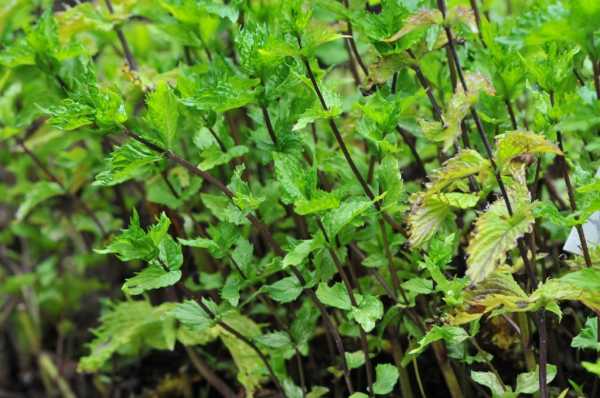

Site preparation and planting material
When choosing a site for planting mint mint, preference should be given to a sunny area with loose soil. For the flea, the northern winds are quite destructive; when the soil dries up, its vegetative organs begin to dry out. The best option is to plant mint mint near buildings and buildings.
See also
Description of menthol mint, planting and care features, harvesting and storage
To read
The preparation of the site for mint mint is carried out in the fall, clearing it of weeds. Under deep digging, rotted manure is added to the ground at the rate of 4-5 kilograms per square meter. Given the small size of the planting material, they should be mixed with clean sand or coffee sediment before laying them in the ground.
Beneficial features
Before proceeding directly to the description of the varieties, a few words should be said about mint in general. The plant is unpretentious and quickly adapts to the surrounding conditions. Does not require fertilizing, regular watering and any special care. Do you want to settle him in the beds? It couldn't be easier! Plant one and it will grow quickly without your input.
Peppermint is known as an effective sedative, but its "powers" do not end there. Fragrant leaves have a tonic, diuretic, choleretic and anti-inflammatory effect.
Like any traditional medicine, mint should not be consumed thoughtlessly, mixed with various medications and making infusions unnecessarily.
Healing properties
Mint is known for its healing effects on the human body. In addition to its pleasant aroma and excellent combination with other herbs when brewing delicious teas, making desserts, sauces, perfumes, it helps to get rid of many ailments.
Peppermint has many medicinal properties:
- Improves blood circulation, while relieving the symptoms of tachycardia, heart palpitations.
- On the basis of the oil, plants are used to make medicines for the treatment of diseases of the digestive tract.
- Essential oil has a positive effect on patients with bronchitis, asthma; helps to eliminate bright attacks in people with tuberculosis.
- In combination with other agents, it is used for women as a prophylaxis and treatment of gynecological problems.
- Helps to cope with stressful conditions, anxiety, anxiety, sleep disorders.
- Eliminates nausea, vomiting, improves appetite.
In the pharmaceutical industry, the properties of mint have been studied for a long time. It is part of the well-known "Validol", beneficial effects on the heart and blood vessels.
Description
Of all the varieties of mint, mint is distinguished (the name "flea" or Georgian ombalo is also used). In terms of external characteristics, this type of mint can be very different from the same meadow mint or garden mint.
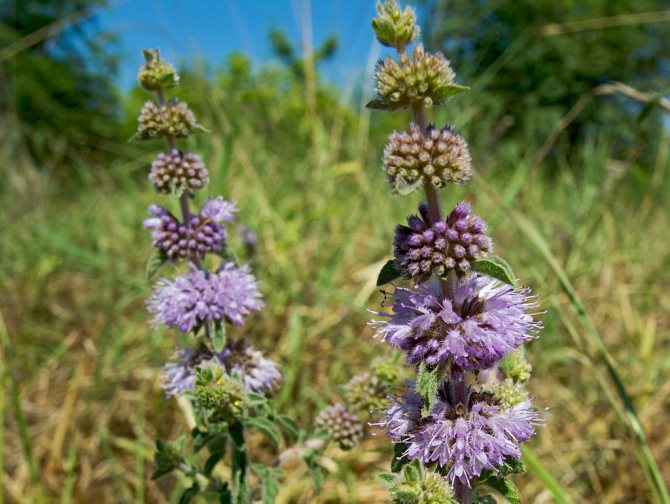

Flea mint
This perennial reaches a maximum of half a meter in height (although there are also "champions", 1 meter high), the stems are smooth, rounded on the cut, branching shoots are located horizontally. Ovate matte leaves are green with a grayish tint, slightly tapering at the ends, serrated at the edges and covered with the finest hairs, have a characteristic delicate and light menthol aroma.
Each leaf, sitting on a short petiole, is located opposite the other, its length is about 2.5 centimeters, and its width is one and a half. Mint inflorescences are numerous and lush, each flower enters a peduncle, similar to a multi-tiered spikelet, they are small, purple in color, closer to pale purple.The corolla of the mint flower has two valves and four petals, while the lower ones are smaller than the one at the top. Mint begins to bloom in June and continues until mid-autumn (most often until September).
The root of the plant is ordinary, threadlike, fibrous, rather branched, which is typical for all varieties of wild and domestic mint.
What a mint fruit looks like is rarely seen, because fruiting is a rather rare phenomenon for this perennial. The fruits (they are called nuts) are placed in cups, they are rough to the touch and covered with villi. Usually there are four nuts on one stalk.
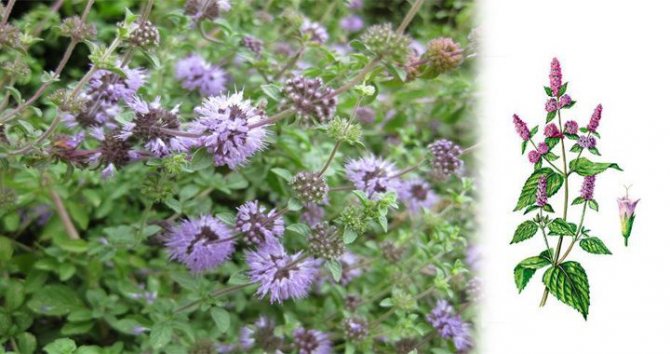

Numerous inflorescences
Characteristics
Marsh mint is widespread on almost all continents, especially in the Caucasus and in the Mediterranean Sea.
The plant contains a large amount of an essential component, the components of which are:
- pullegon (more than 90%);
- azulene;
- limonene;
- menton;
- dipentene.
The composition is determined by the place of growth. The oil is present mainly in foliage and shoots, extraction is carried out from fresh or semi-dry plants with flowers by steam distillation.
Also mint contains tannins, flavonoids, vitamin "C" and the pigment carotene.
Ombalo flea mint how to replace - Summer cottage, garden, vegetable garden, indoor plants
If you want to try to grow an unusual plant on your personal plot, experts advise you to pay attention to ombalo - swamp mint. This name of the plant is widespread in Georgia, in other countries "flea" is more often used. Fragrant greens are used as a seasoning, used for the preparation of various culinary dishes.
Specificity of the variety
Flea mint belongs to the Lamiaceae family and is a perennial herb. The height of the shoots reaches 25-30 cm. Unlike other varieties of mint, the culture has a rounded leaf shape. The plates are wide, wrinkled, curly and slightly pubescent.
A feature of the culture is the long flowering period, which begins in June and lasts until the very frost. Inflorescences form in dense, almost spherical rings. At the time of flowering, they have a pink-purple hue with the presence of a white tube. The flea's advantage is its high rooting ability.
The plant is characterized by a creeping type of growth. It is considered an excellent honey plant.
In the recipes of traditional medicine, she is credited with wound healing, antiseptic and abortive properties.
Under natural conditions, the plant develops in floodplain meadows and on river banks. This culture can be found in Asia, Crimea, the Caucasus and Turkmenistan. Ombalo belongs to the category of heat-loving crops, therefore, if it is insufficient, the yield indicators decrease.
The plant is grown by sowing seeds in the ground, using the seedling method and by dividing the rhizome. The latter method allows you to quickly multiply the culture and, in a short time, significantly increase the planting area. Plants are divided from the beginning of spring. The most popular seed varieties are Penniroyal and Pulegium.
Some gardeners practice potted mint.
The planting time is determined depending on the climatic conditions of the region, for the central Russian territories this is the middle of spring.
Mint seeds are quite small, so growing this way requires certain skills. It is recommended to plant the planting material in sandy soil to ensure better germination. After sowing, cover with foil and put in a lighted place. On average, after 15 days, the first shoots appear, at this moment the film is removed.
When using the division method, adult plants with a well-formed root system are selected for propagation. There should be no signs of putrefactive damage and other kinds of defects on the shoots.After digging, the bush is carefully divided so that each part has a sufficient number of roots and is transplanted to a new place.
Site selection
For planting, open sunny places with sufficient light intake are chosen. The soil must be fertile. The soil is preliminarily prepared by digging well at least on a shovel bayonet. The remains of previous plants must be completely removed, in the fall it is recommended to fertilize the planned planting site with manure at the rate of 3 kg per square meter.
Planting mint
Seedlings are transplanted to a permanent growing site after the threat of frost has passed.
The plant does not survive stress well and does not tolerate temperatures below 8 C.
Planting is carried out in small holes, placing the roots directly on the ground from the growing container. The recommended distance between plants is 30 cm.
Mint is not considered a demanding crop. It is necessary to remove weeds, and when the top layer of the soil hardens, loosen it. With sufficient natural precipitation, the culture can not be watered, moistening is carried out as needed. During the season, 2 fertilizing with complex fertilizers is carried out.
Diseases
Mint is easily susceptible to fungal diseases. Shoots are often attacked by rust or powdery mildew. The first is observed with excessive soil moisture, increased nitrogen content in the soil and cold weather. A preventive measure is compliance with the rules of crop rotation and periodic transplantation of mint bushes.
Pests
Growing can be complicated by pest infestations, as the aromatic seasoning is enjoyed by many insects.
The main danger is associated with invasions of the following insect species:
- aphids;
- spider mite;
- slugs;
- caterpillars;
- leaf beetle.
It is impossible to use chemicals for pest control, therefore, take advantage of the people's councils. For the prevention and control of insects, plantings are sprinkled with ash, treated with a solution of laundry soap, washed with running water from a hose. A good effect is the use of a solution based on garlic or celandine.
Harvesting begins in June, when the greens are formed in sufficient volume. The crop is harvested by hand, choosing healthy foliage. You can store the herb as dry seasoning or frozen.
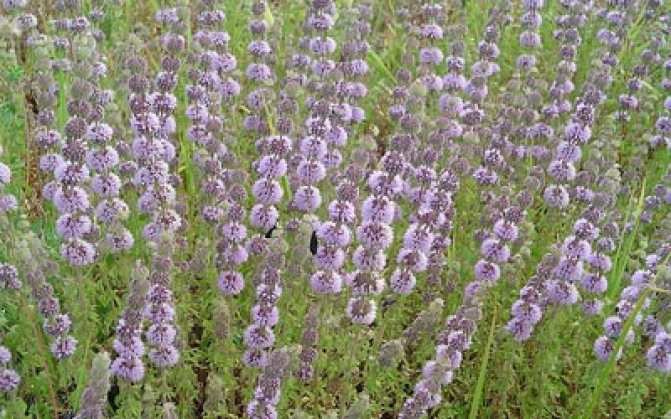

In the latter case, polyethylene bags are more often used, in which mint greens washed and sorted from garbage are placed. For best storage, it is recommended to remove as much air as possible after placing the grass in the bag.
This trick will also significantly save space in the freezer.
For lovers of medicinal and fragrant flowers, experts advise to pay attention to a relative of peppermint - marsh mint and replenish their collection with it. This type combines useful properties and high decorativeness, as well as the ability to mask unsightly areas of the garden with a beautiful carpet.
Definition
It is a spicy-aromatic and medicinal herbaceous perennial, known since ancient times. In ancient Rome and Greece, noble people loved this plant and wore mint wreaths on their heads.
Read more: Cabbage pests: how to treat, how to fight diseases
Its scent was believed to enhance mental performance. In Russia, the Slavs lined the floors of their homes with freshly cut grass and mint.
Marsh mint is also called flea mint or flea, as well as ombalo (this name is common in Georgia).
It has clear differences from other types of mint. Low bushes with frequently spreading shoots and green foliage. Sonia and Penniroyal have the strongest aroma. During the flowering period, it attracts bees and butterflies with a cloud of fragrant flowers that look like lilac rings that clasp the stem.
In nature, it grows along river banks and in flooded meadows. It is found in the wild in East Asia, Europe. Here it grows mainly in the North Caucasus and in the south of Russia.
The plant is artificially cultivated in many countries:
- Spain.
- North Africa.
- Turkmenistan.
The genus Mint (Mentha) belongs to the Lamiaceae family. It is a perennial herb, 30-50 cm high. The stem is round, smooth, well-branched, creeping or erect. Stem and leaves are smooth, may have sparse hairs.
The leaves are set on short petioles, light green, oval, elliptical or oblong-ovoid in shape. The size of the leaf varies from 1 to 5 cm in length and 1.5-3 cm in width. The veins of the leaf are strongly pronounced, giving the leaf a slight relief.
The flowers form in the axils of the leaves and are collected in annular spherical inflorescences. The corolla of the flower is lilac-pink with a white tube. Mint blooms for a long time, from June to November (until the first frost). The fruit is a nutlet, brown, smooth, shiny.
Specificity of the species
The main feature of ombalo is its strong aroma, widely used in:
- perfumery;
- medicine;
- cooking;
- landscape design.
As a culture, mint is a honey plant, unpretentious, quickly grows root mass and takes root easily. Where it grows, it forms a dense flowering carpet.
The flea is a thermophilic plant and can be cultivated in the south of Russia, mainly in the Crimea, in the northern part of the Caucasus.
In a cold climate, you should not expect a bountiful harvest from this crop.
In the northern regions, cultivation is possible with the use of a light shelter for the winter, or a container (or seedling) method of cultivation, when ombalo is planted in the ground only for a favorable summer period.
- Choosing a place for landing. It should be well lit during the day and protected from the winds, with fertile soil rich in organic matter.
- For landing in a permanent place, the soil is prepared in advance.
Since autumn, rotted cow dung is applied to the proposed landing site at the rate of 3 kg per square meter. In the spring, as the snow melts and the surface of the earth warms up, the soil is dug to the depth of the bayonet of the shovel. All roots and parts of weeds are removed. Level with a rake. - The planting is carried out as soon as the threat of spring frosts has passed, and the temperature is set above 18 degrees (at temperatures below 8 degrees, the plant will die). In different years in central Russia, it can be the end of May or mid-June.
In the Crimea and in the south of Russia, it can be planted from mid-April. - Planting can be done by seedling, dividing the bush and rooted cuttings.
Rhizome
It is better to divide the rhizome in spring, when the growth processes are in full swing and the dormant buds will have enough strength for growth and development into a new plant.
- Before dividing, the roots are washed with water and dried in the fresh air.
- With a sharp pruner or knife, cut the root so that at least 8-10 buds (nodes) remain on it.
- The prepared rhizomes are laid out in grooves 10 cm deep, adding a handful of a mixture of humus and charcoal under each root (2: 0.5).
Care rules
- Watering is moderate, with settled water at room temperature.
Marsh mint does not tolerate excessive waterlogging.If the soil is too wet, the plant is often affected by fungal diseases and mold.
- Top dressing after planting seedlings is carried out 2 times per season.
- The first time - in early spring, with mineral fertilizer, with a high nitrogen content. For example, nitroammofoska or urea. Here nitrogen is contained in a form that is easily assimilated for the plant. Fertilizer granules are diluted at the rate of 5 g per 1 liter of water.
- The second is at the beginning of bud formation. Here you can use complex fertilizers for flower crops or phosphorus fertilizers. The most popular fertilizer among gardeners is superphosphate. Breeding rate - 1 tbsp. l. 10 liters. water. Among the liquid dressings, Agricola No. 7 can be distinguished. 5 g of fertilizer (teaspoon) is diluted in 2 liters of water.
- Pruning.
- Sanitary - throughout the season.All dry and diseased shoots are removed, faded shoots are shortened.
- Formative - in spring, during the period of active growth of shoots. The bushes are given the desired shape and appearance.
- Stimulating - is carried out in the form of pinching young growth points to stimulate the growth of vegetative mass.
- Loosening should be done after each watering and in rainy, damp weather.
- Weeding in flea bushes is practically not required, since the culture covers the ground with a carpet, preventing weeds from growing.
Read next: Cherry vocation variety description photo reviews pollinators
Pests and diseases
When to plant a crop
The plant is grown by sowing seeds in the ground, using the seedling method and by dividing the rhizome. The latter method allows you to quickly multiply the culture and, in a short time, significantly increase the planting area. Plants are divided from the beginning of spring. The most popular seed varieties are Penniroyal and Pulegium.
Some gardeners practice potted mint.
The planting time is determined depending on the climatic conditions of the region, for the central Russian territories this is the middle of spring.
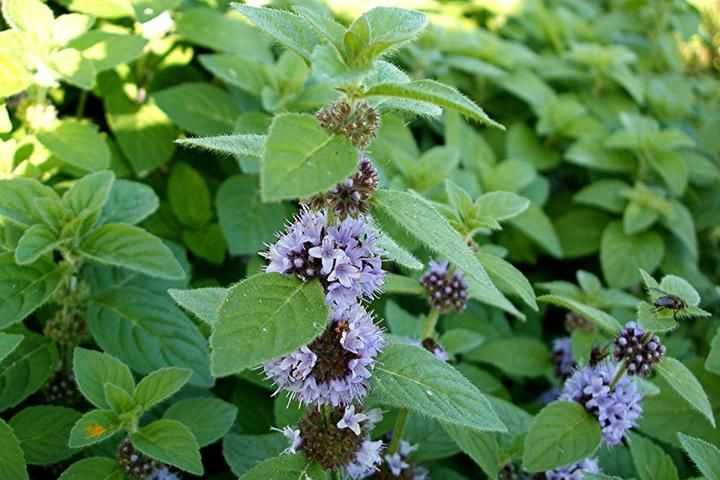

General information about mint
Mint belongs to the Lamiaceae family. The name is associated with Mount Mente in Ancient Greece. The plant originates from Central Asia and the Mediterranean. In our country, it appeared at the turn of the XIX-XX centuries. Today, there are about 40 species and varieties of mint, including hybrids. It grows in its natural environment and is grown in home gardens. Perennial varieties are suitable for all territories, annuals thrive in temperate climates. It grows best in the southern regions, in the Caucasus. The presence of the plant is felt from afar: due to the significant content of essential oils, a strong aroma emanates from it, which intensifies at certain times.
Mint belongs to perennial plants. Its height can reach 1 m, so it is classified as a shrub, but there are also undersized varieties. It has thin stems. They are grouped with inflorescences of miniature flowers, mainly lilac shades, which bloom all summer. The taste of the oblong leaves of a rich green color is menthol, which cools well on a hot day. Petioles and leaves provide invaluable benefits to the body:
- act as an antispasmodic;
- calm the nerves;
- improve respiratory function - they can both fight colds and relieve asthma.
Also, the therapeutic effect of mint is aimed at:
- normalization of blood circulation, prevention of the development of diseases of the heart and blood vessels;
- removal of negative symptoms of the digestive system;
- mitigation of the processes occurring in the female genital area.
Other uses of mint:
- perfumery - many perfumes contain mint elements;
- cosmetology - the production of masks that contain this fragrant plant;
- food industry - adding to salads, making spices, desserts;
- pharmaceuticals - many medicines are created on the basis of mint, designed to relieve a sore throat, to allow you to breathe freely.
You need to know that the plant has not only healing properties. Due to the presence of menthol, it can be harmful if used excessively or incorrectly due to ignorance of the difference in species. Mint is often grown in large quantities for sale.
When and how to collect curly mint
The best time to harvest spearmint is mid-July. At this time, before flowering, the leaves of the plant contain the maximum amount of aromatic substances. Harvesting mint can be done as separate leaves or whole plants, cutting them off and tying them into bunches. This should be done on a warm, dry day, be sure to wait until the morning dew has dried on the leaves.
How to dry curly mint properly
The collected curly mint leaves are scattered on baking trays or plywood boards covered with clean paper, which are placed in a dry, well-ventilated area. At the same time, direct sunlight should not fall on the grass. To prevent the leaves from caking, they need to be stirred periodically. After they become brittle, they are crushed and stored.
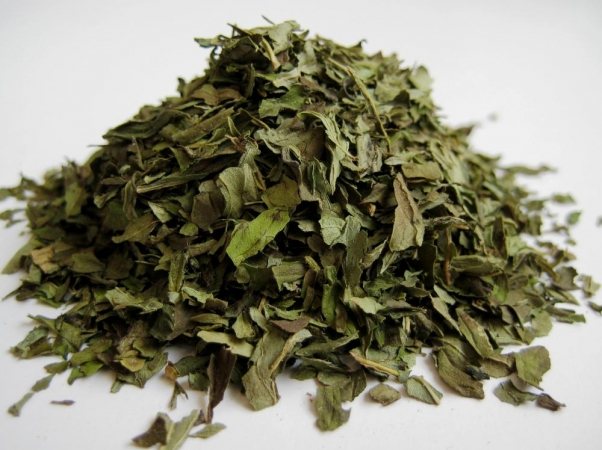

When completely dried, mint leaves rustle and brittle
Important! Plants in bunches are dried in a suspended state.
It is best to store dried spearmint leaves in a tight-fitting glass or earthenware container. The location of the harvested plant material in tightly closed canvas or fabric bags is allowed, but in this case they must be kept in a cool dry room, isolated from other spices.
A short video on drying mint can be viewed at the link below.
Medical applications
Marshmint has a long tradition of drug use, despite the risk of its toxic properties due to the active constituent of pulegon even at low levels. The essential oil should never be taken internally because it can lead to liver or kidney damage, multiple failure, or death in humans and animals.
As an herbal tea, Marshmint has been popular for treating indigestion and bloating, respiratory infections such as colds and flu, and for stimulating sweating.
The darker side of Marshmint is found in its use to induce abortions for unwanted pregnancies. It has also been used to induce menstruation. Although the leaves were commonly used, the essential oil is found where the active ingredients are found in large quantities. It used to be thought that only the leaves would produce the desired effect, however, it is now known that the essential oil will also. Despite this knowledge, it should not be consumed by pregnant women due to the risk of uterine contractions.
Seedling preparation
Curly mint is grown in several ways.
- cuttings;
- seeds;
- seedling.
You need to give preference to cuttings or seedlings.
They begin to prepare the site for planting curly mint in the fall. With the onset of autumn, all weeds are removed, and the soil is dug up to a depth of 10-15 cm. This will prevent insects from appearing in spring. In addition, the soil is watered with a solution of potassium permanganate or iodine. Such disinfection is the prevention of fungi and other diseases.
In the spring, the soil is dug up again and fertilizers are applied. Use mineral and organic fertilizing. Manure, bird droppings, mullein, superphosphate and nitrogen fertilizers are suitable.
Growing conditions
Marshmint requires full lighting for best performance and fertile, well-drained soil. The soil should not be too wet, as the leaves will rot or mold if they are too wet, especially during cold winters. Dry soil in winter allows some measure of frost protection, while marsh soil must withstand up to minus 5 C. However, it loves moist soil, so additional watering will be required in summer.
Most subspecies have roots that travel underground, however, climbing mint also spreads to the surface. This means that wherever a part of the plant touches the ground, a small root system will appear. To propagate, take pieces of stems and plant, or allow the roots to develop and plant when ready.
- If the plant becomes too invasive in any part of the garden, simply dig up that section and discard it carefully.
- If it gets too humid in winter or spring, it can suffer from a rotting type of mold.
Affected leaves should be removed and less water should be provided. Marshmint - grows well in flowerpots.
Definition
Plant varieties
Various types of mint have been discovered: at least 25 varieties, as well as about 10 wild hybrids.They differ in appearance - in leaves, inflorescence roots, in smell and even in their healing properties. Many varieties have a smell similar to citrus fruits.
Lemon
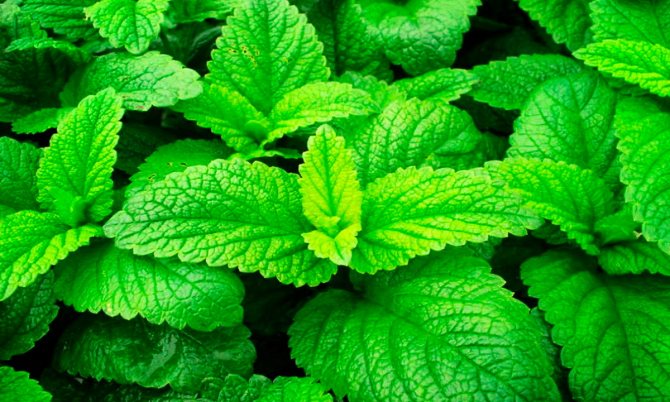

The variety is also called lemon balm. Mint often grows in gardens. It is an easy-care perennial. It can reach a meter high. Under positive conditions, after the color, the seed material scatters, and almost all seeds have excellent germination. The lush shrub has pale greenish foliage, carved along the border.
Growing conditions for curly mint
The variety prefers to grow in open sunny areas. It is advisable to choose such places so that the plants are in the sun in the first half of the day. Preference should be given to moist soils, but not swampy areas.
It is recommended that the soil is fertile, loose, with good aeration. Loamy and sandy loam substrates are suitable. It is undesirable to plant bushes in the shade. They will grow poorly. Every 4 years, the beds are transplanted, and large bushes are planted in different areas.
Spice in cooking
The beneficial properties of mint, its aroma and taste have found application in cooking. The spice is combined with any dishes - meat, fish, vegetables, fruits, desserts, baked goods. Fresh herb is added to hot and cold drinks.
- Mint sauce for meat. Grind 20 grams of mint leaves, cilantro, spinach. Add the grated clove of garlic, a tablespoon of olive oil and a teaspoon of lemon juice. To stir thoroughly.
- Mint yoghurt sauce. Add a bunch of spices chopped with a blender to 100 grams of unsweetened yogurt. Salt and pepper.
- Mint cream. Whip the cream with the egg whites, add the spice chopped in a blender.
- The spice in tea is useful. For its preparation, fresh and dry leaves are used. Tea can be drunk with milk or lemon.
Sprigs of herbs decorate pastries, cocktails. Dried and powdered herbs are used as a spice. Dried mint is added to vegetable stews, tea, baking dough.
View this post on Instagram
Publication by Julia Ponomareva (@ juliettt108) Oct 21, 2019 11:40 am PDT
View this post on Instagram
Posted by Yummy Page (@foodblog_li) Oct 21, 2019 at 1:29 PDT
Limitations and contraindications
Like any plant, ombalo mint has not only beneficial properties, but also has contraindications and can cause side effects. Ombalo mint is not recommended for pregnant and lactating women, children, people with individual intolerance, uterine bleeding and with chronic liver and kidney diseases.
Before consuming ombalo mint, you must remember that the plant is poisonous. When consumed in large quantities, the spice can cause irreparable harm to the body, up to and including death.
When the following first signs of poisoning appear, you must immediately call an ambulance:
- nausea, vomiting;
- severe pain in the epigastric region;
- increased body temperature;
- excitation;
- headache;
- visual hallucinations;
- hearing loss;
- uterine bleeding;
- increased blood pressure;
- shortness of breath, shortness of breath.
Important! When 10 ml of peppermint oil is consumed, a moderate and high degree of toxicity appears, after consuming 15 ml, death occurs within 1-3 hours.
Marsh mint - descriptions and photos of the plant
Botanical name: Mentha pulegium
It is a small climbing perennial plant with glossy green leaves. It reaches a height of only 15 cm and has an indefinite width due to its expanding nature. Grass is capable of curling over the ground surface as well as in soil, taking root from the buds when the vegetative parts touch the ground. This creeping trait means that Marshmint is an ideal climbing plant that is also highly aromatic. There is also a "vertical" subspecies that reaches 30 cm in height. This variety is similar to the previous one, except for the structure and also winds.However, it does not take root easily from the buds.
Tiny purple flowers, gathered in ring-shaped inflorescences, appear in late spring. They are distributed tier-like along the length of the stem, growing out of the buds. Oval dark green glossy leaves are covered with small hairs on both sides. They are arranged in pairs on short legs, on average about 2.5 cm long and 1.5 cm wide. This small plant comes from Europe and parts of Asia, but has spread over a wide area and grows wherever it finds a suitable climate. In particular, it grows well in moist soil near rivers.
The English name was derived from Puliol, an old French name for thyme. It became “Royal Puliol”, then “Puliol Royale” and finally transformed into “Swamp”. In France it is called La Mentha Puliol. The botanical name is Mentha pulegium, where “Mentha” indicates that this plant is classified as a member of the genus “mint”. The name of the species "pulegium" comes from the Latin "pulex", which means "flea". This is a reference to the traditional application for removing fleas using smoke from burning leaves or using a fresh plant. And the Romans knew it simply as Pulegium. Marshmint can also be called creeping grass, mosquito grass, or pudding grass.
There are several varieties that gardeners have bred over the years. The marsh subspecies is very different in shape from species closely related to it. More information on other species can be found below.

